2025-2026 Small Game Forecast
Arizona boasts a myriad of opportunities to hunt small game. Check out the Arizona Game and Fish Department’s forecast, by species, provided by Dr. Larisa Harding, the department’s small game program manager. Refer to the hunting regulations for each species for legal requirements and additional details.

Band-Tailed Pigeon
Daily Bag Limit: Two (2) per day.
Possession Limit: Six (6), of which no more than
two (2) may be taken in any one day.
Note: All hunters 18 and older must be in possession of a valid Arizona hunting license and Arizona migratory bird stamp while in the field. Youth hunters (10 to 17) only need a youth combination hunt and fish license. Those who are under 10 do not need a hunting license when accompanied by a licensed adult (two children per adult).
Where to Hunt: Band-tailed pigeons may be encountered in pine and pine-oak woodlands, and in pinyon-juniper and chaparral habitats throughout Arizona. They are most abundant in the ponderosa pine forests along and below the Colorado Plateau from Flagstaff to the New Mexico border.
Forecast: Pigeons are likely to be more difficult to find this year. With drier conditions across the state, birds that migrated up from Mexico likely struggled to find appropriate food resources and may have gone elsewhere this year. Observations from the field suggest that the poor and spotty monsoons this summer have done little to encourage birds that did come to Arizona to stay, so it may be more challenging to find birds in traditional areas.
Game and Fish has banded band-tailed pigeons this year in Arizona, and some of those banded birds also have transmitters affixed to them. Hunters who harvest a banded bird are encouraged to report the band at reportband.gov. The department urges hunters to return transmitters to any regional office statewide or contact smallgame@azgfd.gov to return them. Transmitters provide valuable data that the department relies upon in the management of pigeons and helps to support hunting opportunities for the gamebirds.

Chukar
Season Dates: Sept. 1, 2025-Feb. 8, 2026.
Daily Bag Limit: Five (5) per day.
Possession Limit: Fifteen (15), of which no more than five (5) may be taken in any one day.
Where to Hunt: Chukars are primarily found north of the Colorado River in deep canyons on the eastern portion of the Arizona Strip, such as Kanab Creek and its tributaries. They generally are encountered in steep, rocky terrain at elevations between 4,500 and 6,500 feet.
Forecast: Plan on doing a lot of rugged and steep hiking to locate chukars. They’re likely to be found in canyons with a water source. Since they’re adapted to arid lands, chukars likely have suffered less than the state’s native quail and grouse species during the drought. Chukars, though, have a reputation for laughing at hunters and flying forever just as those hunters reach their hiding spots.

Dove
Season Dates: Sept. 1, 2025 – Sept. 15, 2025. Also, Nov. 21, 2025 – Jan. 4, 2026.
Daily Bag Limit: Fifteen (15) per day (mourning and white-winged).
Possession Limit: Forty-five (45), of which no more than
fifteen (15) may be taken in any one day. There is no daily
bag or possession limit on invasive Eurasian collared-doves.
Note: All hunters 18 and older must be in possession of a valid Arizona hunting license and Arizona migratory bird stamp while in the field. Youth hunters (10 to 17) only need a youth combination hunt and fish license. Those who are under 10 do not need a hunting license when accompanied by a licensed adult (two children per adult). Hunters who harvest a banded dove are encouraged to report the band at reportband.gov.
Where to Hunt: Mourning doves are found statewide. They reach their greatest abundance in desert lands and adjacent agricultural fields. White-winged doves are primarily inhabitants of Arizona’s desert upland and scrub communities. They usually are encountered within flying distance of saguaros, an important food resource.
Forecast: We’ve seen average numbers of doves this year with the drought, but it’s always difficult to predict how the season will unfold based on monsoon storm activity. Late-summer storms can encourage doves (particularly white-winged) to leave just prior to opening day. Hunters who look for areas near water with roost trees nearby are likely to find at least a few doves. Late-season hunting can be really nice with fewer hunters, cooler weather, and plenty of birds.
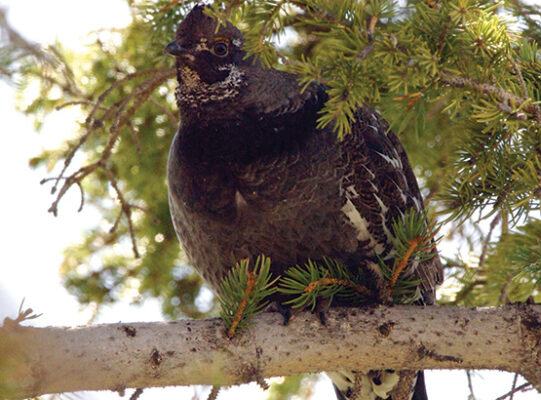
Dusky Grouse
Season Dates: Sept. 1, 2025-Nov. 9, 2025.
Daily Bag Limit: Three (3) per day.
Possession Limit: Nine (9), of which no more than three (3) may be taken in any one day.
Where to Hunt: Dusky grouse are confined almost entirely to spruce-fir forest habitats above 8,500 feet elevation in the White Mountains, Kaibab Plateau and San Francisco Peaks.
Forecast: Scant berry crops and a lack of annual greens, byproducts of the ongoing drought, have likely made it a tough year for grouse across the state. The San Francisco Peaks and the White Mountains have been extremely dry this year, particularly over the summer in the White Mountains. The Kaibab Plateau was dry, but also suffered from two large, late-summer wildfires, the White Sage and Dragon Bravo. The Dragon Bravo burned through much of the better grouse habitat on the North Rim, so its impacts remain to be seen. If the Kaibab Plateau receives favorable moisture over the next few years, it might lead to excellent grouse habitat. Otherwise, numbers may be depressed again on the Kaibab Plateau. In the meantime, the Kaibab National Forest is working to open areas again to the public. For the latest updates on forest road closures and other alerts, including a detailed map, visit https://www.fs.usda.gov/r03/kaibab/alerts.
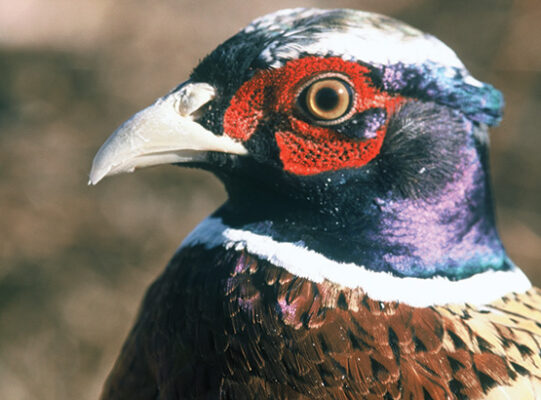
Pheasant
Season Dates: Sept. 1, 2025-Sept. 15, 2025.
Daily Bag Limit: Two (2) per day.
Possession Limit: Six (6), of which no more than two (2) may be taken in any one day
Where to Hunt: Pheasants were widely introduced into Arizona between 1913 and the 1970s, but most of those introductions fared poorly. The only wild population that is open to hunting with firearms is in the agricultural areas south of Yuma, Ariz.
Forecast: Hunters may find an occasional pheasant in the far southwestern corner of Arizona, but numbers have not been high for several years with clean farming practices being enforced on agricultural activities in the area. Be sure to obtain any landowner access permissions before pursuing pheasants.
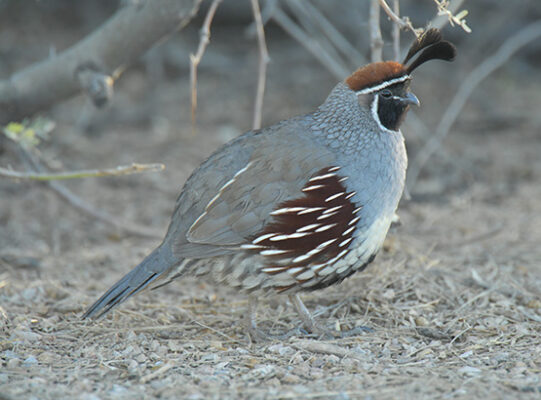
Quail
Season Dates: Oct. 17, 2025-Feb. 8, 2026 (Gambel’s, scaled, California). Also, Dec. 5, 2025-Feb. 8, 2026 (Montezuma, or Mearns’).
Daily Bag Limit: Fifteen (15) per day in the aggregate, of
which no more than eight (8) may be Mearns’ quail.
Possession Limit: Forty-five (45) in the aggregate after
opening day, of which no more than fifteen (15) Gambel’s,
scaled or California quail in the aggregate may be taken in any one day. After Mearns’ season opens, the forty-five (45)
possession limit may include twenty-four (24) Mearns’ quail,
of which no more than eight (8) may be taken in any one day.
Where to Hunt: Gambel’s quail inhabit deserts, low-elevation grasslands, and scrublands, typically below 5,500 feet elevation. Scaled quail are primarily found in southeastern Arizona’s Chihuahuan Desert grasslands. California quail were introduced along the Little Colorado River in the 1960s and remain in this general area in very low numbers today. Montezuma, or Mearns’, quail mostly can be found in the oak and mesquite grassland-woodlands of the southeastern part of the state, south of Tucson, Ariz.
Forecast: Conditions have been extremely dry over the past year. For desert birds, there were good numbers on the ground going into the winter, but the 2024-2025 winter saw little precipitation and virtually no “green-up” this past spring to support breeding activity or chick-rearing. All annual spring call counts for Gambel’s quail were low this year, indicating less breeding and reproduction. As a result, fewer coveys with chicks were observed statewide. The annual spring call counts are a good predictor of what hunters can expect to see in the fall: When the counts are high, harvest numbers tend to be high. Likewise, when the counts are down, hunters can expect a subpar season. There are pockets where birds have fared well enough to produce chicks, but when coveys with chicks are few, predators target young birds more effectively. That makes survival and recruitment of young birds typically lower in years with fewer chicks on the ground. Meanwhile, drought conditions persisted through the summer, driving down Montezuma (Mearns’) quail numbers already impacted by a dry summer in 2024 and low carryover into 2025. With little precipitation this summer, Montezuma quail numbers are expected to be extremely low. As a result, Game and Fish encourages hunters to voluntarily exercise restraint this season — in other words, harvest fewer birds than the limits allow, limit your harvest within individual coveys, and enjoy the other benefits of being outdoors.
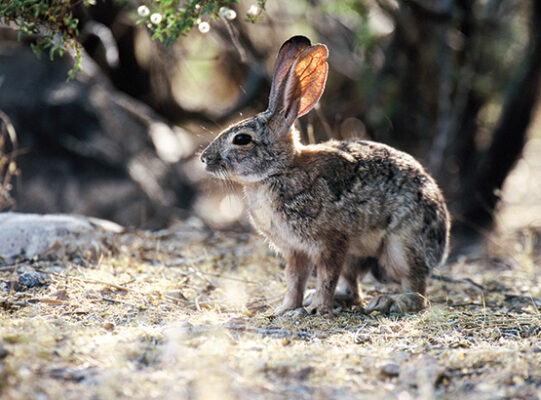
Rabbits and Hares
Season Dates: July 1, 2025-June 30, 2026 (cottontail rabbits,
black-tailed or antelope jackrabbit).
Daily Bag Limit: Five (5) cottontail rabbits per day. Two (2) jackrabbits per day in the aggregate.
Possession Limit: Fifteen (15) cottontail rabbits, of which no
more than five (5) may be taken in any one day. Six (6)
jackrabbits in the aggregate, of which no more than two (2)
may be taken in any one day.
Where to Hunt: The most prevalent of cottontail rabbits in Arizona is the desert variety, which is found throughout the state, with the mountain cottontail at higher elevations across the Mogollon Rim and in the White Mountains. Black-tailed jackrabbits are statewide in distribution, largely found from desert scrub to conifer woodlands. Antelope jackrabbits typically are found below 3,800 feet elevation in south-central Arizona, inhabiting open country from grasslands to desert flats.
Forecast: Cottontail numbers appear to be increasing slowly. Drought conditions have made recovery from the rabbit hemorrhagic virus (RHDV2) slow for both cottontails and jackrabbits, but there are some areas where cottontail numbers appear to be rebounding — though not to pre-RHDV2 levels. For jackrabbits, black-tailed jackrabbit numbers appear to be below average, but relatively stable, while antelope jackrabbit numbers still appear to be depressed. Due to their more social behaviors, antelope jackrabbits saw higher mortality from RHDV2. Add in significant drought impacting both their food and cover resources, and this species just hasn’t rebounded. Expect them to be few and far between on the landscape.
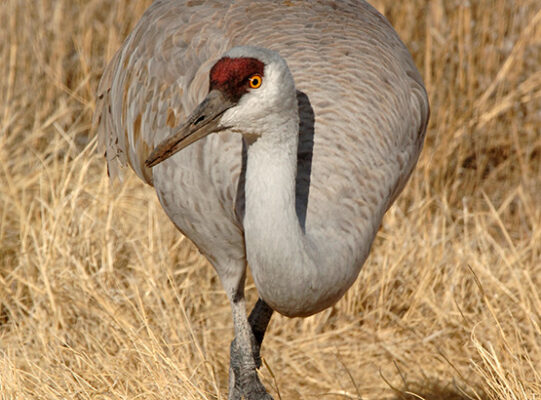
Sandhill Crane
Season Dates: Twenty (20) separate three-day hunts are scheduled to begin between Nov. 21, 2026 and Jan. 24, 2026.
Daily Bag Limit: Three (3) per three-day hunt in a season.
Possession Limit: Six (6) per calendar year, with no more than three (3) taken in any three-day hunt in a season.
Note: Only hunters who were issued hunt permit-tags through the annual application and random draw process in June are permitted to hunt sandhill cranes.
Where to Hunt: Sandhill cranes primarily winter in three localities in Arizona: the Sulphur Springs Valley, along the Gila River near Arlington, Ariz., and in the Safford Valley, and the Colorado River from south of Bullhead City, Ariz., to the general vicinity of Cibola National Wildlife Refuge. Only the Sulphur Springs Valley and the Gila River areas in southeastern Arizona have legal crane hunts, however.
Forecast: A sandhill crane count in January 2025 estimated that more than 38,000 birds were wintering in the Gila River-Sulphur Springs Valley areas in southeastern Arizona. This was down from a high of 47,000-plus a few years ago, but it still represented a robust winter population of cranes. For hunters who were fortunate enough to receive hunt permit-tags this fall, plan on doing some legwork prior to the hunt to obtain landowner access permissions (query “Landowner access” in the search bar on our webpage), call local farmers, or go down a day or two in advance of a hunt to pattern where birds are going to feed. A hunter who just shows up, hoping to find birds on the first day of the hunt, is likely to be disappointed. Invest the time necessary to make that hunting experience a successful one.
For more information about hunting sandhill cranes in Arizona, visit https://www.azgfd.com/hunting/hunt-draw-and-licenses/species-hunt-information/sandhill-crane-hunting-in-arizona/. The department encourages hunters to return to the site and complete a hunter harvest questionnaire after the conclusion of their hunt, even if they chose not to participate or were unsuccessful.

Tree Squirrel
Season Dates: Oct. 3, 2025-Jan. 31, 2026.
Daily Bag Limit: Five (5) per day.
Possession Limit: Fifteen (15), of which no more
than five (5) may be taken in any one day.
Where to Hunt: Arizona’s four species of tree squirrels prefer habitats with mature trees that are tall and have interlocking crowns. These habitats allow tree squirrels to travel and forage without exposing themselves to terrestrial dangers. Large trees not only allow for safe travel, but also offer nesting sites.
Forecast: Tree squirrel numbers were high last year, so there should have been good numbers going into winter 2024. Arizona’s winter conditions were fairly mild, without many storms leaving deep or persistent snows, so squirrels should have fared well through the winter. On the other hand, dry winter and spring conditions coupled with a continued lack of summer monsoon moisture across most of the state, may have severely limited production of fungi and seed cones that the squirrels rely on most of the year. Poor nutrition leads to poor reproduction, so it remains to be seen what squirrel numbers will look like this fall. Expect some areas to hold squirrels from last year, but don’t count on seeing a lot of young animals running through the trees.

Waterfowl and Snipe
Season Dates: Oct. 23, 2025-Jan. 31, 2026. Also, Nov. 7, 2025-
Jan. 31, 2026 (for scaup).
Daily Bag Limit: Visit https://www.azgfd.com/hunting/regulations/ for details.
Possession Limit: Visit https://www.azgfd.com/hunting/regulations/ for details.
Where to Hunt: Ducks are found in all appropriate habitats across the state. They may be encountered on almost any wetland habitat, including stock ponds, marshes, flooded areas, lakes, rivers, canals, etc. While not renowned for its goose hunting, many of Arizona’s wildlife refuges along the Colorado River are well-known goose-hunting areas. Geese also may be encountered on almost any wetland habitat that’s suitable for feeding or loafing.
Note: Game and Fish has banded ducks and Canada geese this year in Arizona. Hunters who harvest a banded bird are encouraged to report the band at reportband.gov.
Forecast: The challenge this year will be to find areas that hold waterfowl. Drought conditions have led to fewer natural ponds and tanks containing water, so waterfowl might be confined to only the largest of reservoirs and rivers in Arizona. Ducks start arriving in Arizona once states to the north begin to see freezing conditions. So, until states like Utah or Idaho see their first cold snap, Arizona may not have ducks in any large numbers. For goose hunters, some Canada geese in the White Mountains may be more “resident” birds than their migratory cousins, so there may be additional opportunities to harvest them prior to the first big cold snap up north.
All hunting regulations can be viewed at https://www.azgfd.com/Hunting/Regulations/.
Need a license? Visit www.azgfd.gov/license/. Keep in mind that a combination hunt and fish license is only $20 more (for state residents) than the price of an individual hunting or fishing license. As a reminder, a youth combination hunt and fish license (ages 10 to 17) is only $5 and includes the privileges associated with the Arizona migratory bird stamp.
The first step in planning that next successful hunt might be to check out the trove of detailed information that’s just a few clicks away on the department’s website. Visit https://www.azgfd.com/hunting/where-to-hunt/. Once there, hunters can select the area they wish to hunt (AZGFD divides the state into six geographical regions), then drill down further by choosing any of several Game Management Units (GMUs) located within that region.
For more hunting information, visit www.azgfd.com/species-category/game/.
NOTE: The U.S. Fish and Wildlife Service has expanded hunting opportunities on national wildlife refuges. These opportunities are authorized and provided on USFWS-managed lands in accordance with federal, state and tribal (where applicable) regulations and seasons. For questions on hunting opportunities, consult the latest refuge hunt regulations.
Small Game Hunt Challenge
For goal-setters who want to experience the satisfaction that comes from completing a worthy challenge, consider participating in the Arizona Small Game Challenge, which consists of four series recognizing the diverse landscapes and hunting opportunities throughout the state.
Hosted by Valley of the Sun Quail Forever, and sponsored by Game and Fish, the challenges aim to expose hunters to learning about new species, harvesting different game, and seeing new parts of the state. Seeking out, preparing, and tasting new game meat are fringe benefits. All hunters who complete one of the four challenges receive an engraving tab for that challenge and a plaque that includes space to place each of the remaining challenge tabs.
In addition, Valley of the Sun Quail Forever matches registration fees, dollar-for-dollar, to enhance Arizona habitats for quail and other small game.
Hunters can register for any one of four different challenges each year. Registration typically opens in August, and participants can report completion of a challenge through late summer of the following year. Registration is $25 per year to participate.
To register, visit https://events.pheasantsforever.org/events/2025-2026-votsqf-arizona-small-game-challenge/a6de3597-942d-4bf7-bb19-c9e9a013c4bf
Small game hunting tips
For hunters of all skill levels, author, biologist, and small game hunting enthusiast Randall D. Babb offers helpful tips. Babb is the author of “An Introduction to Hunting Arizona’s Small Game.”
Want to Go Hunting in Arizona?
Find ways to experience big game and small game hunting or find a mentored hunt camp.
buy your hunting license
Arizona residents and non-residents 10 years and older need a valid hunting license to hunt in Arizona.
find a mentored hunt camp
The award-winning Outdoor Skills Network is your source for hands-on, learn-to-hunt events.
